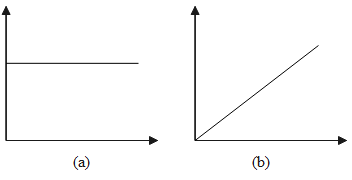
What is the difference between uniform and constant velocity? Is acceleration zero in case of both constant and uniform velocity?
Answer
523.8k+ views
Hint: The velocity can be categorized as uniform and constant taking into consideration the direction and the magnitude of the velocity. The acceleration is the rate of change of velocity. So, we will answer considering the change of velocity concerning the time.
Formula used:
\[a=\dfrac{dv}{dt}\]
Complete step-by-step answer:
The velocity is the rate of change of displacement or position. The velocity is said to be uniform if the body covers equal distance in equal interval of time. The velocity is said to be constant if the body moves along a straight line without changing its direction. Acceleration is the rate of change of velocity.

Graph (a) represents the constant velocity and graph (b) represents the uniform velocity.
In the case of constant velocity, over a period of time, the magnitude of the velocity remains the same, that is, constant, or, it can be said that, there is no change in velocity concerning the time. As the acceleration is rate of change of velocity, thus, acceleration will be zero in the case of constant velocity.
\[\begin{align}
& a=\dfrac{dv}{dt} \\
& \Rightarrow a=\dfrac{0}{dt} \\
& \therefore a=0 \\
\end{align}\]
Again in the case of uniform velocity, over a period of time, the magnitude of the velocity remains the same, that is, constant, or, it can be said that there is no change in velocity concerning the time. As the acceleration is the rate of change of velocity, thus, acceleration will be zero in the case of constant velocity.
\[\therefore \]The velocity is said to be uniform if the body covers an equal distance in an equal interval of time. The velocity is said to be constant if the body moves along a straight line without changing its direction. The acceleration is zero in both cases.
Note: The uniform velocity is also a constant velocity. The change in velocity of a body concerning the time defines the acceleration. So, the magnitude of the velocity is considered while answering.
Formula used:
\[a=\dfrac{dv}{dt}\]
Complete step-by-step answer:
The velocity is the rate of change of displacement or position. The velocity is said to be uniform if the body covers equal distance in equal interval of time. The velocity is said to be constant if the body moves along a straight line without changing its direction. Acceleration is the rate of change of velocity.

Graph (a) represents the constant velocity and graph (b) represents the uniform velocity.
In the case of constant velocity, over a period of time, the magnitude of the velocity remains the same, that is, constant, or, it can be said that, there is no change in velocity concerning the time. As the acceleration is rate of change of velocity, thus, acceleration will be zero in the case of constant velocity.
\[\begin{align}
& a=\dfrac{dv}{dt} \\
& \Rightarrow a=\dfrac{0}{dt} \\
& \therefore a=0 \\
\end{align}\]
Again in the case of uniform velocity, over a period of time, the magnitude of the velocity remains the same, that is, constant, or, it can be said that there is no change in velocity concerning the time. As the acceleration is the rate of change of velocity, thus, acceleration will be zero in the case of constant velocity.
\[\therefore \]The velocity is said to be uniform if the body covers an equal distance in an equal interval of time. The velocity is said to be constant if the body moves along a straight line without changing its direction. The acceleration is zero in both cases.
Note: The uniform velocity is also a constant velocity. The change in velocity of a body concerning the time defines the acceleration. So, the magnitude of the velocity is considered while answering.
Recently Updated Pages
Why are manures considered better than fertilizers class 11 biology CBSE

Find the coordinates of the midpoint of the line segment class 11 maths CBSE

Distinguish between static friction limiting friction class 11 physics CBSE

The Chairman of the constituent Assembly was A Jawaharlal class 11 social science CBSE

The first National Commission on Labour NCL submitted class 11 social science CBSE

Number of all subshell of n + l 7 is A 4 B 5 C 6 D class 11 chemistry CBSE

Trending doubts
What is meant by exothermic and endothermic reactions class 11 chemistry CBSE

10 examples of friction in our daily life

One Metric ton is equal to kg A 10000 B 1000 C 100 class 11 physics CBSE

1 Quintal is equal to a 110 kg b 10 kg c 100kg d 1000 class 11 physics CBSE

Difference Between Prokaryotic Cells and Eukaryotic Cells

What are Quantum numbers Explain the quantum number class 11 chemistry CBSE




